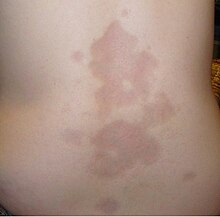
Back Sklerodermie ALS تصلب الجلد Arabic Sklerodermiya AZ ایسکلئرودئرما AZB Склеродерма Bulgarian Esclerodèrmia Catalan سکلێرۆدرما CKB Sklerodermie Czech Dermatosklerose German Σκληρόδερμα Greek
| Scleroderma | |
|---|---|
 | |
| A type of localized scleroderma known as morphea | |
| Specialty | Rheumatology |
| Usual onset | Middle age[1] |
| Types | Localized, systemic scleroderma[2] |
| Causes | Unknown[2] |
| Risk factors | Family history, certain genetic factors, exposure to silica[3][4][5] |
| Diagnostic method | Based on symptoms, skin biopsy, blood tests[6] |
| Differential diagnosis | Mixed connective tissue disease, systemic lupus erythematosus, polymyositis, dermatomyositis[1] |
| Treatment | Supportive care[1] |
| Medication | Corticosteroids, methotrexate, non-steroidal anti-inflammatory drugs (NSAIDs)[2] |
| Prognosis | Localized: Normal life expectancy[7] Systemic: Decreased life expectancy[3] |
| Frequency | 3 per 100,000 per year (systemic)[3] |
Scleroderma is a group of autoimmune diseases that may result in changes to the skin, blood vessels, muscles, and internal organs.[2][6][8] The disease can be either localized to the skin or involve other organs, as well.[2] Symptoms may include areas of thickened skin, stiffness, feeling tired, and poor blood flow to the fingers or toes with cold exposure.[1] One form of the condition, known as CREST syndrome, classically results in calcium deposits, Raynaud's syndrome, esophageal problems, thickening of the skin of the fingers and toes, and areas of small, dilated blood vessels.[1]
The cause is unknown, but it may be due to an abnormal immune response.[2] Risk factors include family history, certain genetic factors, and exposure to silica.[3][4][5] The underlying mechanism involves the abnormal growth of connective tissue, which is believed to be the result of the immune system attacking healthy tissues.[6] Diagnosis is based on symptoms, supported by a skin biopsy or blood tests.[6]
While no cure is known, treatment may improve symptoms.[2] Medications used include corticosteroids, methotrexate, and non-steroidal anti-inflammatory drugs (NSAIDs).[2] Outcome depends on the extent of disease.[3] Those with localized disease generally have a normal life expectancy.[7] In those with systemic disease, life expectancy can be affected, and this varies based on subtype.[3] Death is often due to lung, gastrointestinal, or heart complications.[3]
About three per 100,000 people per year develop the systemic form.[3] The condition most often begins in middle age.[1] Women are more often affected than men.[1] Scleroderma symptoms were first described in 1753 by Carlo Curzio[9] and then well documented in 1842.[10] The term is from the Greek skleros meaning "hard" and derma meaning "skin".[11][12]
- ^ a b c d e f g "Scleroderma". NORD (National Organization for Rare Disorders). 2007. Archived from the original on 8 September 2016. Retrieved 14 July 2017.
- ^ a b c d e f g h "Scleroderma". GARD. 2017. Archived from the original on 25 January 2017. Retrieved 14 July 2017.
- ^ a b c d e f g h Jameson L (2018). "Chapter 353". Harrison's Principles of Internal Medicine (20th ed.). McGraw Hill.
- ^ a b Barnes J, Mayes MD (March 2012). "Epidemiology of systemic sclerosis: incidence, prevalence, survival, risk factors, malignancy, and environmental triggers". Current Opinion in Rheumatology. 24 (2): 165–70. doi:10.1097/BOR.0b013e32834ff2e8. PMID 22269658. S2CID 24050211.
- ^ a b Greenblatt MB, Aliprantis AO (January 2013). "The immune pathogenesis of scleroderma: context is everything". Current Rheumatology Reports. 15 (1): 297. doi:10.1007/s11926-012-0297-8. PMC 3539168. PMID 23288576.
- ^ a b c d "Handout on Health: Scleroderma". NIAMS. August 2016. Archived from the original on 4 July 2017. Retrieved 15 July 2017.
- ^ a b Unsal E (2006). Current Opinions in Pediatric Rheumatology. Nova Publishers. p. 302. ISBN 9781594548710. Archived from the original on 2017-09-06.
- ^ Denton CP, Khanna D (October 2017). "Systemic sclerosis". Lancet. 390 (10103): 1685–1699. doi:10.1016/s0140-6736(17)30933-9. PMID 28413064. S2CID 22247432.
- ^ Mackay IR, Rose NR (2006). The Autoimmune Diseases. Academic Press. p. 369. ISBN 9780080454740.
- ^ Firestein GS, Kelley WN, Budd RC (2012). Kelley's Textbook of Rheumatology. Elsevier Health Sciences. p. 1366. ISBN 978-1437717389. Archived from the original on 2017-08-04.
- ^ Harper D. "scleroderma". Online Etymology Dictionary.
- ^ σκληρός, δέρμα. Liddell, Henry George; Scott, Robert; A Greek–English Lexicon at the Perseus Project.